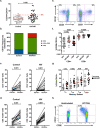The tetraspanin CD151 marks a unique population of activated human T cells
- PMID: 32978478
- PMCID: PMC7519159
- DOI: 10.1038/s41598-020-72719-8
The tetraspanin CD151 marks a unique population of activated human T cells
Abstract
Tetraspanins are a family of proteins with an array of functions that are well studied in cancer biology, but their importance in immunology is underappreciated. Here we establish the tetraspanin CD151 as a unique marker of T-cell activation and, in extension, an indicator of elevated, systemic T-cell activity. Baseline CD151 expression found on a subset of T-cells was indicative of increased activation of the MAPK pathway. Following TCR/CD3 activation, CD151 expression was upregulated on the overall T-cell population, a quintessential feature of an activation marker. CD151+ T-cell frequencies in the spleen, an organ with increased immune activity, were twice as high as in paired peripheral blood samples. This CD151+ T-cell frequency increase was not paralleled by an increase of CD25 or CD38, demonstrating that CD151 expression is regulated independently of other T-cell activation markers. CD151+ T-cells were also more likely to express preformed granzyme B, suggesting that CD151+ T cells are pro-inflammatory. To this end, HIV-1 patients on antiretroviral therapy who are reported to exhibit chronically elevated levels of immune activity, had significantly higher CD4+CD151+ T-cell frequencies than healthy controls, raising the possibility that proinflammatory CD151+ T cells could contribute to the premature immunological aging phenotype observed in these patients.
Conflict of interest statement
The authors declare no competing interests.
Figures






Similar articles
-
Tetraspanins CD9 and CD151 at the immune synapse support T-cell integrin signaling.Eur J Immunol. 2014 Jul;44(7):1967-75. doi: 10.1002/eji.201344235. Epub 2014 Apr 29. Eur J Immunol. 2014. PMID: 24723389 Free PMC article.
-
CD151 supports VCAM-1-mediated lymphocyte adhesion to liver endothelium and is upregulated in chronic liver disease and hepatocellular carcinoma.Am J Physiol Gastrointest Liver Physiol. 2017 Aug 1;313(2):G138-G149. doi: 10.1152/ajpgi.00411.2016. Epub 2017 May 4. Am J Physiol Gastrointest Liver Physiol. 2017. PMID: 28473332 Free PMC article.
-
Integrin-free tetraspanin CD151 can inhibit tumor cell motility upon clustering and is a clinical indicator of prostate cancer progression.Cancer Res. 2014 Jan 1;74(1):173-87. doi: 10.1158/0008-5472.CAN-13-0275. Epub 2013 Nov 12. Cancer Res. 2014. PMID: 24220242 Free PMC article.
-
Tetraspanin-enriched Microdomain Containing CD151, CD9, and TSPAN 8 - Potential Mediators of Entry and Exit Mechanisms in Respiratory Viruses Including SARS-CoV-2.Curr Pharm Des. 2022;28(46):3649-3657. doi: 10.2174/1381612828666220907105543. Curr Pharm Des. 2022. PMID: 36173052 Review.
-
The tetraspanin CD151 in papillomavirus infection.Viruses. 2014 Feb 18;6(2):893-908. doi: 10.3390/v6020893. Viruses. 2014. PMID: 24553111 Free PMC article. Review.
Cited by
-
CD151 interacts with integrin beta 2 in B cell lymphomas.Cell Mol Life Sci. 2025 Jun 4;82(1):221. doi: 10.1007/s00018-025-05747-0. Cell Mol Life Sci. 2025. PMID: 40464949 Free PMC article.
-
Compositional analysis of lymphocytes and their relationship with health outcomes: findings from the health and retirement study.Immun Ageing. 2025 Mar 12;22(1):12. doi: 10.1186/s12979-025-00505-z. Immun Ageing. 2025. PMID: 40075474 Free PMC article.
-
Combined exome and transcriptome sequencing of non-muscle-invasive bladder cancer: associations between genomic changes, expression subtypes, and clinical outcomes.Genome Med. 2022 Jun 3;14(1):59. doi: 10.1186/s13073-022-01056-4. Genome Med. 2022. PMID: 35655252 Free PMC article.
-
Possible Role of Extracellular Vesicles in Hepatotoxicity of Acetaminophen.Int J Mol Sci. 2022 Aug 9;23(16):8870. doi: 10.3390/ijms23168870. Int J Mol Sci. 2022. PMID: 36012131 Free PMC article.
-
Systems analysis unravels a common rural-urban gradient in immunological profile, function, and metabolic dependencies.Sci Adv. 2025 May 2;11(18):eadu0419. doi: 10.1126/sciadv.adu0419. Epub 2025 Apr 30. Sci Adv. 2025. PMID: 40305616 Free PMC article.
References
-
- Berditchevski F. Complexes of tetraspanins with integrins: More than meets the eye. J. Cell Sci. 2001;114:4143–4151. - PubMed
Publication types
MeSH terms
Substances
Grants and funding
LinkOut - more resources
Full Text Sources
Molecular Biology Databases
Research Materials

